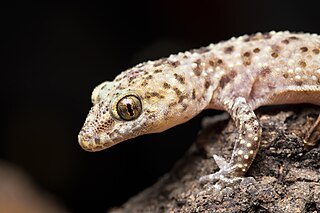
Hemidactylus is a genus of the common gecko family, Gekkonidae. It has 195 described species, newfound ones being described every few years. These geckos are found in all the tropical regions of the world, extending into the subtropical parts of Africa and Europe. They excel in colonizing oceanic islands by rafting on flotsam, and are for example found across most of Polynesia. In some archipelagoes, cryptic species complexes are found. Geckos like to live in and out of houses. They have been introduced to many areas around the world.

The Indo-Pacific gecko, also known commonly as Garnot's house gecko, fox gecko, and the Assam greyish brown gecko, is a species of lizard in the family Gekkonidae. The species is found in India, across Southeast Asia, Australia, and throughout Polynesia. Adults are about 4 to 5 in in total length. They are seen as dark gray or brown with light markings in daylight and a pale, translucent colour at night. The belly is orange or yellow. The head has a long, narrow snout, hence the name fox gecko. The flattened tail has a row of spiny scales on the lateral edges. The species is parthenogenic – all individuals are female and lay eggs that hatch without requiring male fertilisation.
Dravidogecko anamallensis, also known as the Anamalay gecko, Anaimalai dravidogecko, or Anamalai Hill gecko, is a species of gecko found in the South Indian hills of Palni, Anamalai and Tirunelveli. It is assigned to the genus Dravidogecko, with a resurrection in 2019, as a study suggested molecular phylogenetics is to have had a separate origin from the other Hemidactylus species.

Hemidactylus prashadi, also known commonly as the Bombay leaf-toed gecko or Prashad's gecko, is a species of lizard in the family Gekkonidae. The species is endemic to the Western Ghats of India.

The Mediterranean house gecko is a species of house gecko native to the Mediterranean region, from which it has spread to many parts of the world including parts of East Africa, South America, the Caribbean, and the Southern and Southeastern United States. It is commonly referred to as the Turkish gecko as represented in its Latin name and also as the moon lizard because it tends to emerge in the evening.

The tropical house gecko, also called commonly the Afro-American house gecko and the cosmopolitan house gecko, is a species of house gecko, a lizard in the family Gekkonidae. The species is native to sub-Saharan Africa. However, it is also found in North, Central and South America and the Caribbean, where it has been inadvertently introduced by humans.

The common house gecko is a gecko native to South and Southeast Asia as well as Near Oceania. It is also known as the Asian house gecko, Pacific house gecko, wall gecko, house lizard, tiktiki, chipkali or moon lizard.
Hemidactylus foudaii, also known commonly as the Elba gecko, is a species of lizard in the family Gekkonidae. The species is native to North Africa.

The Mount Sinai gecko is a species of lizard in the family Gekkonidae. The species is endemic to Egypt.

The carrot-tail viper gecko is a species of gecko. It is found in Iran, Pakistan and possibly India, although the Indian records are questionable.

The Antilles leaf-toed gecko, also known as the Maria Islands leaf-toed gecko or spiny gecko, is a gecko species found in northern South America and the Lesser Antilles. It can be found on small rocks and islets offshore of Saint Lucia, Trinidad, and Tobago, though it is absent from the main islands.
Hemidactylus eniangii is a species of forest gecko found in Nigeria and northern Cameroon. It inhabits lowland tropical moist forest at elevations of 10–960 m (33–3,150 ft) above sea level and can be locally very common.
The Bioko leaf-toed gecko is a species of forest geckos from Bioko Island. It occurs in the coastal areas of the island and it has also been found in a forest immediately adjacent to the beach.
Hemidactylus bouvieri, also known commonly as Bouvier's leaf-toed gecko and the Cape Verde leaf-toed gecko, is a species of lizard in the family Gekkonidae. The species is endemic to the Cape Verde Islands and is listed as critically endangered. There are two recognized subspecies.

The banded leaf-toed gecko is a species of gecko. It is endemic to West Africa west of the Dahomey Gap, from southern Guinea to Togo.
Hemidactylus modestus, also known as the moderate leaf-toed gecko or Tana River gecko, is a species of gecko. It is endemic to Kenya.
Hemidactylus tanganicus, also known as the Tanzania leaf-toed gecko, Tanzanian diamond gecko or Dutumi gecko, is a species of gecko. It is endemic to Tanzania.

The Gujarat gecko is a species of gecko. This gecko specie is endemic to Gujarat state of India. It was first recorded in Girnar hills of Gujarat.
Hemidactylus ituriensis is a species of gecko. As currently known, it is endemic to northeastern Democratic Republic of Congo, although its true range probably extends eastwards to Uganda and Kenya. It belongs to the "Hemidactylus fasciatus species group".
Treutler's gecko is a species of lizard in the family Gekkonidae. The species is endemic to India.











